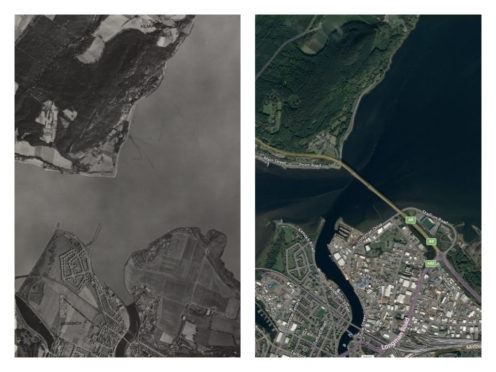A fascinating interactive map of parts of Inverness and Fort Williams illustrate how the areas have changed since the Second World War.
Aerial photography of the two largest settlements in the Highlands from the 1940s and the present day can be compared using a digital spyglass viewer.
Inverness was dubbed the fastest growing city in western Europe in the noughties and unsurprisingly, its landscape has changed a lot since the 1940s.
One of the first things that stands out from our first overview showing the Black Isle and the north part of the city is the creation of the Kessock Bridge.
It opened in 1982 and created a whole raft of changes on both sides of the Beauly Firth. Check out how the modern-day Longman and Harbour Road areas looked back then, there was not much to them.
There was also a lot of expansion around Merkinch and Scorguie. Perhaps most interestingly of all, is the Moray Firth coast where Caley Thistle’s stadium now sits.
Check out how the coastline changes, thanks to the reclamation of land using rocks, sand and soil close to the old Longman dump.
The south side of Inverness is continually expanding and areas like Inshes, Slackbuie and Milton of Leys have become some of the most sought-after locations in the city.
Culduthel Road is a thoroughfare cutting almost through the centre of modern Inverness but back in the 1940s it acted more like a town boundary.
Across central Inverness, there is a more familiar look as the main parts of the modern city centre have retained their structure.
In Fort William, the growth of areas like Caol, Corpach and Banavie are seen clearly on the comparison map.
The Lochaber smelter, which dates back to the 1920s and is expected to be part of an alloy wheels factory project opening next year, is visible in both aerial shots on the east part of the town.
The National Library of Scotland’s maps room shared a link to the Ordnance Survey air photo mosaics with its Spyglass viewer on Twitter to celebrate World Photo Day.
The mosaics provide information on the landscape of post-war Scotland, including detail of urban topography and land-use.
They complement paper mapping and represent the first widespread use of aerial survey methods by Ordnance Survey.
Due to post-war budget constraints, the 1940s photographs were taken from Spitfires and Mosquitos rather than slower aircraft more suited to aerial survey, and the planes were modified to take two cameras under each wing.










